The traditional system, a network of small interconnecting streets, has greater automobile capacity and greater efficiency than fewer, wider streets with the same total number of lanes. This information is contained in the Highway Capacity Manual, the main handbook of traffic engineers. This is because of intersection delays.
A traditional system shortens the average travel distance. It also makes it much easier to combine several trip destinations into one trip (e.g., commute and errands). A traditional system offers many redundant opportunities to make left turns, and enables drivers to make "real-time" route decisions, a very efficient process. (Left-turning cars can still be passed by removing some parking spaces.) A hierarchical system gathers up left turns on arterials and forces them to single locations, giving a loss of green time to through traffic.
A traditional system has pedestrians crossing only two lanes of traffic. A six-lane hierarchical has seven to nine traffic lanes to cross (including left-turn or double-left-turn lanes, and often right-turn-only lanes). This can multiply by four the red signal time when pedestrians need to cross. It also exposes pedestrians to more hazards.
A traditional system has fewer signal lights and four-way stop signs. The need for signal lights is greatly reduced because there is much less load at any given intersection. A hierarchical arterial has higher speeds but much greater delays at intersections.
For most automobile trips, a traditional system has lower travel speeds but average travel still time less than that of a hierarchical system. For pedestrian, transit and bicycle modes, a hierarchical system often increases travel time by several times over a traditional system.
 A
traditional street. The A-trains of the Key
System (shown) went between San Francisco and San Leandro. They
were articulated as light rail transit is today. The Oakland traffic
engineering department wanted trains eliminated near Lake Merritt in
an attempt to aleviate traffic congestion there. In 1950, the
"heavily used" A-line was severed, preventing trains from continuing
beyond Lake Merritt, where the tracks were converted to more
automobile traffic lanes. Eliminating the trains increased automobile
capacity, but people capacity became a small fraction of what it was
with the trains. Of course, long-term congestion was made much worse
as people were forced into automobiles. As a result of a hostile
takeover by General Motors Corp. in 1946, the transit company
supported its own destruction.
A
traditional street. The A-trains of the Key
System (shown) went between San Francisco and San Leandro. They
were articulated as light rail transit is today. The Oakland traffic
engineering department wanted trains eliminated near Lake Merritt in
an attempt to aleviate traffic congestion there. In 1950, the
"heavily used" A-line was severed, preventing trains from continuing
beyond Lake Merritt, where the tracks were converted to more
automobile traffic lanes. Eliminating the trains increased automobile
capacity, but people capacity became a small fraction of what it was
with the trains. Of course, long-term congestion was made much worse
as people were forced into automobiles. As a result of a hostile
takeover by General Motors Corp. in 1946, the transit company
supported its own destruction.Most collector streets, which today usually have four lanes and/or commercial zoning, had a streetcar line if they existed prior to the 1950s. Prior to that time, arterials and freeways rarely existed. This gives an insight to what needs to happen today.
Increasing roadway capacity involves adding more transit vehicles and/or giving signal pre-emption for transit, not adding more lanes of polluting and inefficient automobiles, or destroying productive land with freeways, arterials and parking lots. This means that roadway capacity is defined in terms of moving people (contrasted with moving motor vehicles).
The traditional system, with destinations abutting the street, is ideal for light rail transit. It is still common in Europe today to walk out of a supermarket on to a streetcar stop with a bag of groceries. The distance is less than walking across most of a typical mall parking lot. Small neighborhood markets are also very common.
Automated Guideway Transit (AGT), sometimes called People Movers, a new form of guideway transportation, needs to be evaluated for future guideway transit projects. Like light rail transit, pedestrian and bicycle travel modes, AGT is much more compatible with a traditional, rather than hierarchical, system.
Much of this section was adapted from "Traditional neighborhood
development. Will the traffic work?" by Walter Kulash; Glatting Lopez
Kercher Anglin, Inc.; Orlando Florida.